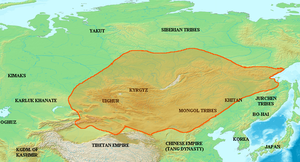Grão-Canato Uigur
| Grão-Canato Uigur | |||||||||
|---|---|---|---|---|---|---|---|---|---|
| |||||||||
| |||||||||
 Grão-Canato Uigur em seu auge
| |||||||||
| Região | |||||||||
| Capital | |||||||||
| Países atuais | |||||||||
| Língua oficial |
| ||||||||
| Religião | |||||||||
| Grão-cã | |||||||||
| |||||||||
| Período histórico | Idade Média | ||||||||
| |||||||||
Estados antecessores e sucessores
| |||||||||
Grão-Canato Uigur[3] (em turco antigo: 𐱃𐰆𐰴𐰕:𐰆𐰍𐰕:𐰉𐰆𐰑𐰣, Toquz Oγuz budun; em uigur: ئۇيغۇر خانلىقى, Uiğur Xanliqi; em chinês: 回鹘 ou 回纥, Huíhú[4] ou Huíhé[5]) também chamado Império Uigur[6] ou País Oguz Tocuz,[7] foi um império turcomano que existiu por aproximadamente um século dos séculos VIII ao IX.[8] Eram uma confederação tribal sob a nobreza uigur de Orcom (回鶻), referida pelos chineses como Jiu Xingue ("Nove Clãs"), um calque do nome Tocuz Oguz ou Tocuz Tugueluque.[9]
Referências
- ↑ a b Rachewiltz 2013, p. 164.
- ↑ Millward 2007, p. 43.
- ↑ Jivkov 2015, p. 40.
- ↑ Jin 2017, p. 70.
- ↑ Finley 2013, p. 85.
- ↑ Kamberi 2015, p. 7.
- ↑ Levi 2010, p. 29.
- ↑ Benson 1998, p. 16–19.
- ↑ Bughra 1983, p. 50–51.
Bibliografia
[editar | editar código-fonte]- Benson, Linda; Svanberg, Ingvar (1998). China's last Nomads: the history and culture of China's Kazaks. Londres e Nova Iorque: Routledge
- Bughra, Imin (1983). The history of East Turkestan. Istambul: Publicações de Istambul
- Finley, Joanne N. Smith (2013). The Art of Symbolic Resistance: Uyghur Identities and Uyghur-Han Relations in Contemporary Xinjiang. Leida e Nova Iorque: Brill
- Jin, Yijin (2017). Islam. Leida e Nova Iorque: Brill
- Jivkov, Boris (2015). Khazaria in the Ninth and Tenth Centuries. Leida e Nova Iorque: Brill
- Kamberi, Dolkun (2015). Uyghurs and Uyghur Identity. Washington: Radio Free Asia
- Levi, Scott Cameron (2010). Islamic Central Asia: An Anthology of Historical Sources. Bloomington e Indianápolis: Imprensa da Universidade de Indiana
- Millward, James A. (2007). Eurasian Crossroads: A History of Xinjiang. Londres: Hurst Publishers
- Rachewiltz, Igor de (2013). The Secret History of the Mongols, VOLUME 3 (Supplement): A Mongolian Epic Chronicle of the Thirteenth Century. Leida e Nova Iorque: Brill
Text is available under the CC BY-SA 4.0 license; additional terms may apply.
Images, videos and audio are available under their respective licenses.






